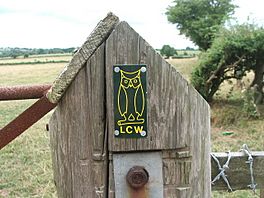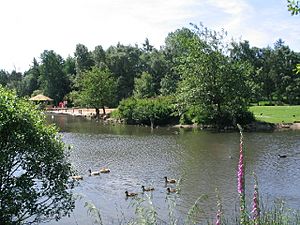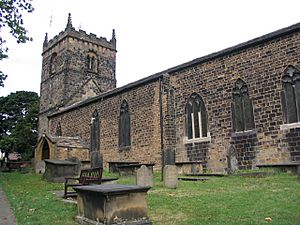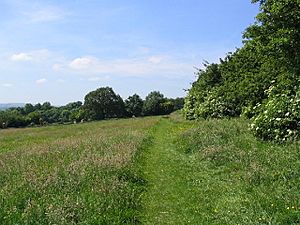Leeds Country Way facts for kids
Quick facts for kids Leeds Country Way |
|
|---|---|

LCW waymarker near Wike
|
|
| Length | 62 mi (100 km) |
| Location | Leeds, West Yorkshire, England |
| Trailheads | Circular walk, accessible by bus or train at many points |
| Use | Hiking, Running |
| Difficulty | Easy: some short hills and can be muddy in places |
| Season | All year |
| Hazards | Crosses some busy roads |
The Leeds Country Way is a long walking path that goes all the way around the city of Leeds, West Yorkshire, England. It's a big circle, about 62 miles (99 km) long! Even though it's never more than 7 miles (11 km) from the very center of Leeds (called City Square), most of the path feels like you're out in the countryside. You'll see amazing views of the areas around Leeds. The path uses public footpaths, bridleways (paths for horses), and small lanes, with only a few short parts on main roads.
Contents
History of the Leeds Country Way
The idea for this path first came from Fred Andrews, who was part of the Ramblers Association. Then, the West Yorkshire County Council helped develop it in the early 1980s.
When that council was closed down in 1986, the path became the responsibility of the Countryside section of Leeds City Council. In 2006, the Leeds Country Way was changed a bit by Bob Brewster. This change made sure the entire path stayed within the Leeds area. Before, it used to cross into Wakefield. The path was officially reopened on September 26, 2006, with new maps and better signs to guide walkers.
Exploring the Leeds Country Way Route
The Leeds Country Way has signs pointing in both directions, so you can start walking from anywhere you like. However, the official maps describe the path starting from Golden Acre Park and going clockwise (like the hands of a clock). The route is split into four main parts, and each part has smaller sections.
Part 1: Golden Acre Park to Barwick-in-Elmet
Section 1: Nature and TV Sets
This part of the path starts in Golden Acre Park. You'll walk through the park and past the Yorkshire Wildlife Trust's Adel Dam Nature Reserve. You'll also follow a bit of the Meanwood Valley Trail. For a short time, the path joins up with the Leeds link to the Dales Way near Eccup Reservoir. After that, it crosses the Ebor Way and enters the Harewood Estate. Here, you might spot what looks like a tiny village. It's actually the set for the famous TV show Emmerdale! Keep an eye out for red kites too; these birds have been successfully brought back to this area.
Section 2: Historic Villages
After crossing the busy A61 road, the path goes north of Wike. Then, it reaches the village of Bardsey. This village has an old Anglo-Saxon church tower and a pub called the Bingley Arms. This pub claims to be the oldest in England! The path then turns south, crosses the A58, and leads to Scarcroft.
Section 3: Maypoles and Ancient Forts
The path continues through Thorner, crossing the A64. Finally, you'll enter Barwick-in-Elmet. This village is famous for having England's tallest maypole. It also has a Norman motte (a type of castle mound) and an Iron Age fort.
Part 2: Barwick-in-Elmet to Carlton
Section 1: Motorways and Towns
From Barwick, the path goes past the southern edge of Scholes. Then, it crosses the M1 motorway and enters the town of Garforth.
Section 2: Old Railways and Rivers
The path leaves Garforth by following an old, unused railway line. This line was once part of the North Eastern Railway. You'll then get close to Swillington and pass Little Preston Old Hall. The path goes around St Aidan's Country Park and crosses the River Aire at Swillington Bridge. After crossing, the path follows the river downstream, past a marina at Fleet Bridge.
Section 3: Canals and Rhubarb
The path continues along the river, which here is part of the Aire and Calder Navigation (a system of canals). It leads to Mickletown and then turns south towards Methley. The path then swings east, crosses the A642, and continues to Carlton. This area is known as the heart of the West Yorkshire Rhubarb Triangle, famous for growing rhubarb!
Part 3: Carlton to Cockersdale
Section 1: Hills and Valleys
From Carlton, the path crosses open fields. It briefly joins the A61 and crosses the M1 again, south of Robin Hood. It then turns south, crosses the M62, and follows the valley of Dolphin Beck. Finally, it reaches East Ardsley on the A650.
Section 2: Historic Buildings
From East Ardsley, the path goes around the south of West Ardsley. It then reaches Woodkirk, which has a very old church, on the A653. You'll pass the ruins of Howley Hall, a grand house built in 1590. After that, the path goes downhill to Scotchman Lane.
Section 3: Woods and Busy Roads
A track through Birkby Brow Wood, which is right on the border between Leeds and Kirklees, leads to the A643. You'll follow this road to cross the M62 motorway again. The path then has its longest section of walking along a road, the A650, through Gildersome. After that, a series of field paths leads to Cockersdale, which is on the A58 near Tong.
Part 4: Cockersdale to Golden Acre Park
Section 1: Beck Valleys and City Borders
The path follows the valley of Cockersdale and then goes along Tong Beck. It passes below Fulneck Moravian Settlement and goes around the south of Pudsey. At this point, Tong Beck forms the border between Leeds and Bradford. The path crosses the railway line that goes from Leeds to Bradford and meets the busy A647 at Thornbury.
Section 2: Quarries and Canals
Walking past playing fields and old quarries, the path crosses the Woodhall Hills. It then follows Fagley Beck to cross the Leeds and Liverpool Canal and the River Aire at Apperley Bridge. The path then follows the river past Woodhouse Grove School before climbing up to meet the A65 south of Rawdon.
Section 3: Airports and Nature Reserves
From here, the path goes around Horsforth. For a while, it follows the southern edge of Leeds Bradford International Airport. It then goes around the northern part of Cookridge before crossing Breary Marsh Local Nature Reserve. Finally, you'll return to Golden Acre Park, completing the full circle!
Handy Tips for Walking the Way
Since the Leeds Country Way is a circular path, you can start your walk from any point. However, the official maps suggest starting and finishing at Golden Acre Park and walking clockwise. The route is divided into four main parts, each with three sections.
You can choose how you want to split up your walk. There are many bus routes and several train stations nearby, like Woodlesford, Garforth, New Pudsey, and Horsforth. This makes it easy to get to and from the path. West Yorkshire Metro can give you information about buses and trains in the area.
If you like using maps, the Ordnance Survey maps that cover the route are:
- Landranger 1:50,000 sheet 104 (Leeds: covers most of the path) and 105 (York: needed for a small part near Garforth).
- Explorer 1:25,000 sheets 289 (Leeds: from Golden Acre Park clockwise to Scotchman Lane) and 288 (Bradford: from Scotchman Lane clockwise back to Golden Acre Park).
The path is marked with a special owl symbol. This owl comes from the Leeds coat of arms, which is the city's official symbol.
The original route of the path is also used for an annual trail running relay race. This race is organized by Kippax Harriers. Teams of twelve runners, with two runners taking on each of the six sections, complete the whole route in about seven hours!





